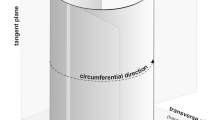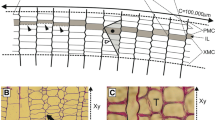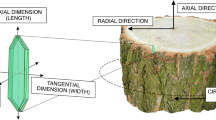Abstract
Based on mathematical modelling, this review article describes the mechanism of expansion in the circumference of vascular cambium due to radial growth leading to increase in the tree-trunk diameter, and emphasizes upon the huge difference in the rate of symplastic growth of cambial initials in two different directions, viz. radial and circumferential. On the basis of anatomical evidence regarding the role of symplastic and intrusive growths, the long-standing hypothesis that the intrusive growth contributes to the increase of cambium circumference has been falsified. It has been shown with the help of mathematical calculations as well as anatomical observations that only symplastic growth of the initial cells (in circumferential direction) is responsible for the expansion of cambial circumference.







Similar content being viewed by others
Abbreviations
- S:
-
Surface of a cylinder (S = 2πrh)
- h:
-
Height of cambial cylinder
- C:
-
Circumference of cambial cylinder (C = 2πr)
- Ci :
-
Tangential dimension of initial cell (part of cambial circumference occupied by one initial).
- ΔC:
-
Change in circumference
- ΔCL :
-
Increase in circumference of layer of cambial initials after addition of one cell layer on xylem side (ΔCL = 2πΔrL)
- ΔC1 :
-
Increase in the Earth’s perimeter after addition of 1 m to its radius
- ΔCi :
-
Increase in cambial circumference per one fusiform initial (ΔCi = ΔCL / N)
- N:
-
Number of cambial initial cells on the cambial circumference
- r:
-
Radius
- ri :
-
Radial dimension of one initial cell
- Δr:
-
Change in radius
- ΔrL :
-
Change in radius of cambial cylinder caused by the deposition of one cell layer on xylem side
References
Bailey, I. W. 1923. The cambium and its derivative tissues IV. The increase in girth of the cambium. American Journal of Botany 10: 499–509.
Bannan, M. W. 1950. The frequency of anticlinal divisions in fusiform cambial cells of Chamaecyparis. American Journal of Botany 37: 511–519.
Bannan, M. W. 1957. The relative frequency of the different types of anticlinal divisions in conifer cambium. Canadian Journal of Botany 35: 875–884.
Bannan, M. W. 1960. Cambial behavior with reference to cell length and ring width in Thuja occidentalis L. Canadian Journal of Botany 38: 177–183.
Beck, C. B. 2010. An introduction to plant structure and development. Cambridge University Press, Cambridge.
Carlquist, S. 2010. Comparative wood anatomy. Systematic, ecological, and evolutionary aspects of dicotyledon wood. Springer-Verlag, Germany.
Crang, R., S. Lyons-Sobaski & R. Wise. 2018. Plant Anatomy: a concept-based approach to the structure of seed plants. Springer Nature Switzerland AG. Cham.
Cumbie, B. G. 1984. Origin and development of the vascular cambium in Aeschynomene virginica. Bulletin of the Torrey Botanical Club 111: 42–50.
Dickison, W. C. 2000. Integrative plant anatomy. Academic Press, San Diego.
Esau, K. 1965. Plant anatomy. Wiley, New York.
Evert, R. F. 1961. Some aspects of cambial development in Pyrus communis. American Journal of Botany 48: 479–488.
Evert, R. F. 2006. Esau’s plant anatomy: meristems, cells and tissues of the plant body: their structure, function, and development. Wiley, New Jersey.
Forest, L., J. San Martin, F. Padilla, F. Chassat, F. Giroud & J. Demongeot. 2004. Morphogenetic processes: application to cambial growth dynamics. Acta Biotheoretica 52: 415–438.
Harris, J. M. 1989. Spiral grain and wave phenomena in wood formation. Springer-Verlag, Berlin.
Hejnowicz, Z. 1961. Anticlinal divisions, intrusive growth, and loss of fusiform initials in nonstoried cambium. Acta Societatis Botanicorum Poloniae 30: 729–758.
Hejnowicz, Z. 1967. Interrelationship between mean length, rate of intrusive elongation, frequency of anticlinal divisions and survival of fusiform initials in cambium. Acta Societatis Botanicorum Poloniae 36: 367–378.
Hejnowicz, Z. 1980. Tensional stress in the cambium and its developmental significance. American Journal of Botany 67: 1–5.
Hejnowicz, Z. 2012. Anatomia i histogeneza roślin naczyniowych. Organy wegetatywne. PWN, Warszawa.
Hejnowicz, Z & S. Brański. 1966. Quantitative analysis of cambium growth in Thuja. Acta Societatis Botanicorum Poloniae 35: 395–400.
Hejnowicz, Z & B. Zagórska-Marek. 1974. Mechanism of changes in grain inclination in wood produced by storeyed cambium. Acta Societatis Botanicorum Poloniae 43: 381–398.
Iqbal, M. 1994. Structural and operational specializations of the vascular cambium of seed plants. Pp. 211–271. In: M. Iqbal (ed.), Growth patterns in vascular plants. Dioscorides Press, Portland.
Iqbal, M. 1995. Structure and behaviour of vascular cambium and the mechanism and control of cambial growth. Pp. 1–67. In: M. Iqbal (ed.), The cambial derivatives. Gebrüder Borntraeger, Stuttgart.
Iqbal, M & A. K. M. Ghouse. 1990. Cambial concept and organisation. Pp. 1–36. In: M. Iqbal (ed.), The vascular cambium. Research Studies Press/Wiley, Taunton.
Jura, J., P. Kojs, M. Iqbal, J. Szymanowska-Pułka & W. Włoch. 2006. Apical intrusive growth of cambial fusiform initials along the tangential walls of adjacent fusiform initials: evidence for a new concept. Australian Journal of Botany 54: 493–504.
Karczewska, D., J. Karczewski, W. Włoch, J. Jura-Morawiec, P. Kojs, M. Iqbal & J. Krawczyszyn. 2009. Mathematical modeling of intrusive growth of fusiform initials in relation to radial growth and expanding cambial circumference in Pinus sylvestris L. Acta Biotheoretica 57: 331–348.
Kojs, P. 2012. A qualitative model of symplastic and intrusive growth of the vascular cambium of broadleaved trees – a biomechanical perspective. (pp. 344–345). In: 7th Plant Biomechanics International Conference. Clermont-Ferrand.
Kojs, P, W. Włoch, A. Rusin, W. Szendera, Duda, J. J Jura & T. Rusin. 2002. Od niefunkcjonalnej do funkcjonalnej piętrowości kambium. Modele piętrowości. Biuletyn Ogrodów Botanicznych 11: 93–104.
Kojs, P, W. Włoch, A. Rusin & W. Szendera. 2003. Storeyed structure of cambium as an adaptive strategy to environmental conditions in trees forming the canopy and emergent layer of the tropical rain forests. Biuletyn Ogrodów Botanicznych 12: 23–29.
Kojs, P, A. Rusin, M. Iqbal, W. Włoch & J. Jura. 2004a. Readjustments of cambial initials in Wisteria floribunda (Willd.) DC for development of storeyed structure. New Phytologist 163: 287–297.
Kojs, P, W. Włoch & A. Rusin. 2004b. Rearrangement of cells in storeyed cambium of Lonchocarpus sericeus (Poir.) DC connected with formation of interlocked grain in the xylem. Trees 18: 136–144.
Kwiatkowska, D. & J. Nakielski. 2011. Mechanics of the meristems. Pp. 133–172. In: P. Wojtaszek (ed.), Mechanical integration of plant cells and plants. Springer, Berlin, Heidelberg.
Larson, P. R. 1994. The vascular cambium: development and structure. Springer–Verlag, Berlin.
Mahmood, A. 1968. Cell grouping and primary wall generations in the cambial zone, xylem, and phloem in Pinus. Australian Journal of Botany 16: 177–195.
Majumdar, G. P. 1941. The sliding, gliding, symplastic or the intrusive growth of the cambium cells and their derivatives in higher vascular plants. Journal of the Indian Botanical Society 20: 161–171.
Mauseth, J. D. 1988. Plant anatomy. The Blackburn Press, Caldwell.
Miczajka, S., A. Gizińska, A. Miodek & A. B. Wilczek. 2014. Adjustment of storied pattern of vascular cambium of Caragana arborescens Lam. branches. Nature Journal 47: 45–60.
Miodek, A., A. Gizińska, A. Wilczek & W. Włoch. 2013. Growth of wood fibers in circular-symmetrical annual xylem increment. In: Interdyscyplinarne i aplikacyjne znaczenie nauk botanicznych (pp. 114–115). Streszczenia wystąpień ustnych 56. Zjazdu Polskiego Towarzystwa Botanicznego. Olsztyn.
Miodek, A., A. Gizińska, M. Klisz, T. Wojda, K. Ukalski & P. Kojs. 2020. Direct exposure to solar radiation causes radial growth eccentricity at the beginning of the growing season in Robinia pseudoacacia. IAWA Journal 41: 61–84.
Philipson, W. R., J. M. Ward & B. G. Buterfield. 1971. The vascular cambium, its development and activity. Chapman and Hall Ltd., London.
Romberger, J. A., Z. Hejnowicz & J. F. Hill. 1993. Plant Structure: function and development. Springer-Verlag, Berlin.
Schmitt, U., G. Koch, D. Eckstein, J-W. Seo, P. Prislan, J. Gričar, K. Čufar, H. Stobbe & R. Jalkanen. 2016. The vascular cambium of trees and its involvement in defining xylem anatomy. Pp. 3–24. In: Y. S. Kim, R. Funada & A. P. Singh, (eds), Secondary xylem biology; origins, functions, and applications. Academic Press, Amsterdam.
Sinnott, E. W. & R. Bloch. 1939. Changes in intercellular relationships during the growth and differentiation of living plant tissues. American Journal of Botany 26: 625–634.
Steeves, T. A. & I. M. Sussex 1989. Patterns in plant development. Cambridge University Press, Cambridge.
Wenham, M. W. & F. Cusick. 1975. The growth of secondary wood fibres. New Phytologist 74: 247–261.
Wilczek, A. 2012. The formation of heterogeneous storeys in the cambium on the example of Laburnum anagyroides Medik. Acta Agrobotanica 65: 47–56.
Wilczek, A, J. Jura-Morawiec, P. Kojs, M. Iqbal & W. Włoch. 2011a. Correlation of intrusive growth of cambial initials to rearrangement of rays in the vascular cambium. IAWA Journal 32: 313–331.
Wilczek, A, W. Włoch, M. Iqbal & P. Kojs. 2011b. Position of rays and lateral deviation of vessel elements in the stem wood of some dicotyledonous species with storeyed, double-storeyed, and nonstoreyed cambia. Botany 89: 849–860.
Wilczek, A, Gizińska, A. A Miodek & W. Włoch. 2014. Nowa hipoteza wzrostu promieniowego i przebudowy kambium waskularnego roślin drzewiastych. Kosmos 63: 591–601.
Wilczek, A, M. Iqbal, W. Włoch & M. Klisz. 2018. Geometric analysis of intrusive growth of wood fibres in Robinia pseudoacacia. IAWA Journal 39: 191–208.
Włoch, W. 1976. Cell events in cambium, connected with the formation and existence of a whirled cell arrangement. Acta Societatis Botanicorum Poloniae 45: 313–326.
Włoch, W & E. Połap. 1994. The intrusive growth of initial cells in re-arrangement of cells in cambium of Tilia cordata Mill. Acta Societatis Botanicorum Poloniae 63: 109–116.
Włoch, W, E. Mazur & P. Kojs. 2001. Intensive change of inclination of cambial initials in Picea abies (L.) Karst. tumours. Trees 15: 498–502.
Włoch, W, E. Mazur & M. Bełtowski. 2002. Formation of spiral grain in the wood of Pinus sylvestris L. Trees 16: 306–312.
Włoch, W, J. Jura-Morawiec, P. Kojs, M. Iqbal & J. Krawczyszyn. 2009. Does intrusive growth of fusiform initials really contribute to circumferential growth of vascular cambium? Botany 87: 154–163.
Włoch, W, A. Wilczek, J. Jura-Morawiec, P. Kojs & M. Iqbal. 2013. Modelling for rearrangement of fusiform initials during radial growth of the vascular cambium in Pinus sylvestris L. Trees 27: 879–893.
Author information
Authors and Affiliations
Corresponding author
Rights and permissions
About this article
Cite this article
Miodek, A., Włoch, W., Iqbal, M. et al. Controversy over the Mode of Growth of Cambial Cylinder. Bot. Rev. 87, 243–257 (2021). https://doi.org/10.1007/s12229-020-09237-9
Accepted:
Published:
Issue Date:
DOI: https://doi.org/10.1007/s12229-020-09237-9




